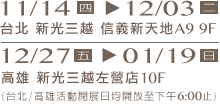
臺灣工藝競賽傳統工藝組 評審感言
Preface by the juror of the Traditional Craft Group
人類開始啟動身體應用身外之物,即是工藝的起源。長遠的歷史歲月裡,工藝隨著人們的需求與經驗累積,不斷演化至今,多采多姿的工藝表現,正是無數的工藝家們從經驗累積、實作探險、淬煉心思的結果。工藝發展的長遠脈絡中,一種兼具美與用的工藝哲學,始終與工具技術導向及藝術美學導向,有著難以區別的曖昧與混沌關係。因此,工藝家能透過熟稔的巧工匠心,融合人們生活文化、美感經驗,創造出令人讚賞的工藝傑作。
2013臺灣工藝競賽傳統工藝組的競賽提出與創新設計組區別的說明【揉合傳統工藝文化、精神及技術,發揮創作美學。】即是工藝創作的原點。傳統工藝組競賽,其根源於傳統工藝精神的創作,雖不如當代藝術擁有更開放的實驗空間,但是工藝家從傳統文化及技術的涵養,透過創新精神與企圖,提出具有目的與意義之創作,以提升當代生活文化與產業發展之企圖,這是工藝競賽之意義與理想所在。參加本次傳統工藝組之工藝作品計有266(組)件,其中通過初選有90件,複選通過有47件,最後經過決選評定特別獎、一等獎、二等獎、三等獎各1件,以及佳作8件。每位評審與參賽作品歷經初審、複審,以及決審的冗長過程,審慎嚴謹的提出今年的得獎作品。
今年參賽作品在工藝的品項呈現多樣,整體作品在技術表現精進,美感意境脫俗,以及富含文化底蘊的主題創意,可說是今年工藝競賽傳統工藝組的特色,而本屆參賽送件總數量卻較去年稍微減少。本次傳統工藝組得獎作品中,發現幾項特色:純熟精巧的工藝技術,創新獨具的將文化傳統底蘊昇華成為作品內涵;從當今生活經驗聯想出發,創作具有傳統文化內涵或意義;及從精湛工藝技術表現當今生活文化經驗等特質,這也呈現當代臺灣工藝的多元面向與可能性。
工藝競賽匯集臺灣工藝家智慧與體力的創作結晶,累積臺灣工藝文化的能量與交流機會,也提升生活美學與文化品味的價值。工藝,不僅是一種美感的表達與機能考量,更成為形塑意義與印象的線索來源。衷心期盼工藝家能精進工藝創作提升生活文化,也期望國人能因工藝有更美好生活。
國立臺北教育大學藝術與造形設計學系教授 劉得劭
The tradition of craft began when mankind began to use tools instead of their hands. In the long history of humanity, craft evolved along the development of the different needs and experiences of mankind. Up till today, an extensive variety of craft presentations have been developed from the accumulated experiences, practice, exploration, and creative minds of numerous craftsmen. In the context of the long craft history, the philosophy of craft, that is, an integration of aesthetics and function, has been in an ambiguous and tangled relationship with the tool-technology oriented and artistic aesthetic oriented production. And that is why works fusing the craftsmen’s ingenuity, the culture of the people, and aesthetic experiences are widely admired throughout history.
“Manifesting creative aesthetics in a fusion of the culture, spirit, and technology of traditional crafts”- the central concept for the “Traditional Craft Group” of the “2013 Taiwan Crafts Competition”, which sets this group apart from the Creative Design Group, is indeed the fundamental concept of craft. Competition in the traditional craft group emphasizes the context of traditional culture and technology. It may not be as open and experimental as the contemporary arts, but the craftsmen achieve the ideology of upgrading the contemporary living culture and industries through innovative and creative attempts inspired by the traditional culture and technology. This is exactly the meaning and mission of this craft competition. A total of 266 entries have been sent in for the Traditional Craft Group, 90 entries were short-listed in the preliminary stage, and 47 entries were nominated in the review stage. In the final review, the jurors selected one entry each for the “Special Award” and the first, second, and third place winners, as well as 8 entries for Honorable Mention. Every juror went through the long process of preliminary, review, and final review in the most stringent manner to select this year’s winning entries.
This year’s entries were characterized by high diversity with advanced technical presentation, unique aesthetics, and rich cultural context. Overall, there have been unique entries in the Traditional Craft Group, but there was also a slight decline in the quantity. The awarding entries in this year’s Traditional Craft Group is characterized by several features: transcendence of traditional culture through unique innovative ideas and mature technology, reinterpretation of the context or meaning of traditional culture from contemporary living experiences, and the presentation of contemporary cultural experiences through advanced craft techniques. These characteristics present the diversity and possibilities of contemporary craft development in Taiwan.
The “Taiwan Crafts Competition” is an arena showcasing the fruits of craftsmen’s ingenuity and stamina, a platform facilitating accumulation of energy and exchange of experiences in Taiwan’s craft and cultural industry, and a mechanism which drives the industry to continuously upgrade living aesthetics and create cultural values. Craft is not just a presentation of aesthetics or functions; it is a carrier of cultural meanings and impressions. I expect that the craftsmen in Taiwan will continuously develop and refine the living culture in Taiwan through continuous creative work, and the people in Taiwan will continuously upgrade the quality of their lives through the refined crafts ingeniously created by craftsmen of Taiwan.
“Manifesting creative aesthetics in a fusion of the culture, spirit, and technology of traditional crafts”- the central concept for the “Traditional Craft Group” of the “2013 Taiwan Crafts Competition”, which sets this group apart from the Creative Design Group, is indeed the fundamental concept of craft. Competition in the traditional craft group emphasizes the context of traditional culture and technology. It may not be as open and experimental as the contemporary arts, but the craftsmen achieve the ideology of upgrading the contemporary living culture and industries through innovative and creative attempts inspired by the traditional culture and technology. This is exactly the meaning and mission of this craft competition. A total of 266 entries have been sent in for the Traditional Craft Group, 90 entries were short-listed in the preliminary stage, and 47 entries were nominated in the review stage. In the final review, the jurors selected one entry each for the “Special Award” and the first, second, and third place winners, as well as 8 entries for Honorable Mention. Every juror went through the long process of preliminary, review, and final review in the most stringent manner to select this year’s winning entries.
This year’s entries were characterized by high diversity with advanced technical presentation, unique aesthetics, and rich cultural context. Overall, there have been unique entries in the Traditional Craft Group, but there was also a slight decline in the quantity. The awarding entries in this year’s Traditional Craft Group is characterized by several features: transcendence of traditional culture through unique innovative ideas and mature technology, reinterpretation of the context or meaning of traditional culture from contemporary living experiences, and the presentation of contemporary cultural experiences through advanced craft techniques. These characteristics present the diversity and possibilities of contemporary craft development in Taiwan.
The “Taiwan Crafts Competition” is an arena showcasing the fruits of craftsmen’s ingenuity and stamina, a platform facilitating accumulation of energy and exchange of experiences in Taiwan’s craft and cultural industry, and a mechanism which drives the industry to continuously upgrade living aesthetics and create cultural values. Craft is not just a presentation of aesthetics or functions; it is a carrier of cultural meanings and impressions. I expect that the craftsmen in Taiwan will continuously develop and refine the living culture in Taiwan through continuous creative work, and the people in Taiwan will continuously upgrade the quality of their lives through the refined crafts ingeniously created by craftsmen of Taiwan.
Professor, Department of Arts and Design,National Taipei University of Education
Te-Shao Liu















